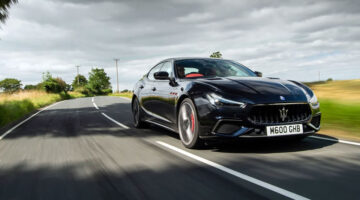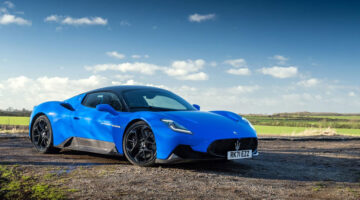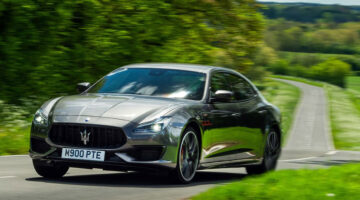Ah, the good life – once intrinsically linked to Italian carmakers like Maserati, responsible for the quintessential GT car, the Ghibli. Can the latest version hope to emulate its greatness? We drive both to find out
GT. Two little letters affixed to so many cars, the origin of so many genres yet so few people know what exactly they stand for.
Gran Turismo. Grand Touring. The joy of motoring distilled into a badge.
To understand the true essence of GT, to appreciate the unique appeal of what Gran Turismo is all about, we need to go back long before the automobile was even thought of as a concept. Back before railways and the industrial revolution, as far as the 1600s, to a time when only the ruling elite and super rich could afford to travel any further than the next village or town.
The sons (and eventually daughters, too) of these wealthy families used to travel through Europe as one of the final stages of their education, often spending months visiting foreign cities. This rite of passage came to be known as The Grand Tour and required comfortable, spacious and luxurious carriages that horses could pull at high speeds. When these young men returned to their home countries, the things they had seen and experienced then came to influence architecture, cuisine and even language. As travel became more accessible to the masses, Grand Tours ceased to be, but if they’d still been taking place in the late 1960s or early 1970s, I can’t help but feel that the carriage of choice might have been the Maserati Ghibli. It embodies everything that grand touring was about.
The mid-1960s were the absolute zenith for the world of GT sports cars and this is especially true for Italian manufacturers like Maserati. It was the heyday of crossing continents with speed and great comfort and few cars offered such a heady combination of power, luxury and style as the Ghibli. It’s one of the truly great GT cars – a low-slung, sleek, fast and glamorous machine that made more sense at the time than Ferrari’s difficult 365 GTB/4, commonly known as the Daytona. Unveiled at the 1966 Turin Motor Show, it replaced the Sebring a year later and remained in limited production until 1973, with fewer than 1190 examples built, including 125 Spyders and 250 SS cars with the more powerful 4.9-litre engine.
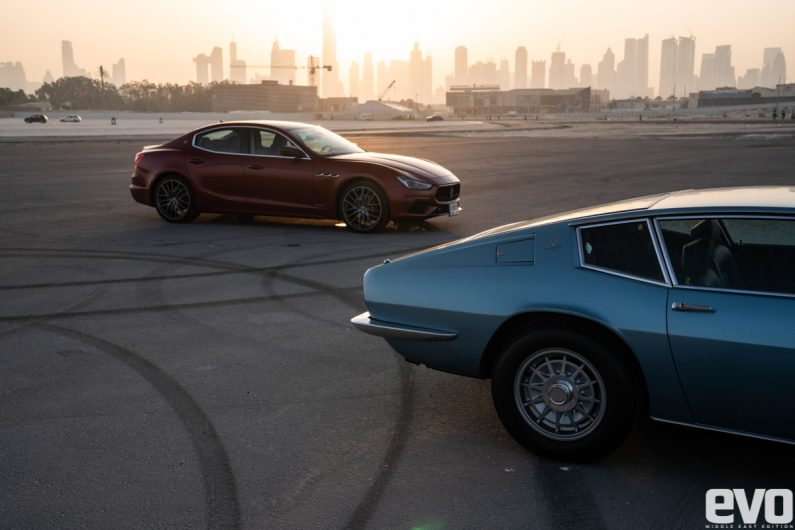
It was a darling of the jet set, with famous owners including Peter Sellers, Frank Sinatra and Sammy Davis Junior. And since its demise with the introduction of the rakish Khamsin that replaced it, there have been two further trident-badged Ghibli models. The second was a boxy coupe that evolved from the tragic Biturbo and was produced by a then beleaguered Maserati between 1992 and 1998. Now, though, Maserati is a very different company and today’s Ghibli is an entirely different proposition. And that’s why we have this duo here, in the pages of evo – not as a direct comparison between old and new, you understand, but more as a celebration of past glories and an insight into the current fortunes of perhaps motoring’s most evocative name.
Ghibli is derived from Arabic and is the name given to the hot Saharan winds that sweep across the Libyan shorelines, whipping up fine sand to form floating orange clouds that shape-shift over the warm landscape. Mistral, Khamsin, Bora, Merak, Shamal and Karif – all these classic Maseratis were named after winds. I love this stuff. It shows effort and imagination on their part while the majority of carmakers simply resort to emotionless alpha-numerics.
It is breathtakingly beautiful when you see it for real and, Lotus Esprit aside, is possibly Giorgetto Giugiaro’s finest hour. He was a young designer working for the Ghia studios in Turin when he penned this most elegant of shapes in just three months. It went on to inspire an entire generation of exotic machinery and is viewed by many as the last ‘real’ Maserati, developed before Citroën took over the company in 1968 and effectively ruined it. The Ghibli, in many respects, marked the end of an era.
The Celeste Blue example I’m privileged to be driving on this warm Friday morning in Dubai is part of the collection offered by Tomini Classics and, as we head to the first photo location in convoy, I’m in the new one – a full-fat S GranSport. It’s been three years since I was last in a modern Ghibli, it being the S version when the model line was still in its infancy – a car I recall being extremely impressed by. But as Assyl Yacine, Tomini’s gregarious manager and all-round good guy is driving the old timer along a six-lane highway while dawn breaks, the sonorous blare of its V8 and the sheer bloody coolness of this grandest of grand tourers means I’m having difficulty keeping my eyes on the road. And with those lamps raised, it somehow looks even better – a hint of aggression added to its pure, chiselled nose. What a glorious sight it is to behold.
As I soldier on and try to resist gazing longingly at it from my own driver’s seat, I cannot help but feel that Maserati needs to get back some of this long lost glamour. As a brand it’s a bit dusty, a bit faded, having lost some of its magical draw in its chase for mass production. The Alfieri concept car that had the world dropping its collective jaw more than four years ago has still not materialised as a production model and it’s desperately needed. It’s about as close to the original Ghibli in concept and execution than anything Maserati has produced in four decades and, well, just take a look at it. It’s stunning and should be built.
Not that the latest Ghibli is a duff car. Far from it, in fact, and during the short dawn drive it still manages to feel special in a way that its Germanic rivals just don’t. As with Alfa Romeo, Maserati has struggled for decades to make good on its promises and the Ghibli was the car that finally started bagging awards. Its raucous exhaust note got millions talking as a result of the ‘Strike’ Superbowl ad in February 2014 but that investment, estimated by those in the know to have been in the region of $16 million, is unlikely to have paid off in the long term. Momentum has never really been evident. And that’s a shame because, while it’s not perfect, it really is a
good car.
It needs to be great, though. Good just doesn’t cut it anymore I’m afraid, and Maserati needs to stop trading on past glories. The GranSport is the more focused trim level available on the Ghibli S and it’s the result of gentle and occasional refining, just massaging away some of the car’s more irksome attributes to make a machine that’s as dynamic and as desirable as any saloon has a right to be. But it’s expensive, to the point that adding a few tasty options like the Skyhook suspension gets you dangerously close to the BMW M5. Performance wise, it doesn’t stand a chance against the German and that’s a worrying situation.
The original, though, had few, if any peers. The Daytona was like a truck to drive in comparison, while the Jensen Interceptor, Iso Grifo, Lamborghini Espada all had their fans and offered crushing abilities but none of the cache or heritage of the Maserati name. In any case, it did the job of a GT car better than any of them – a flagship model that could hold its head high with the best and fastest the world had to offer.
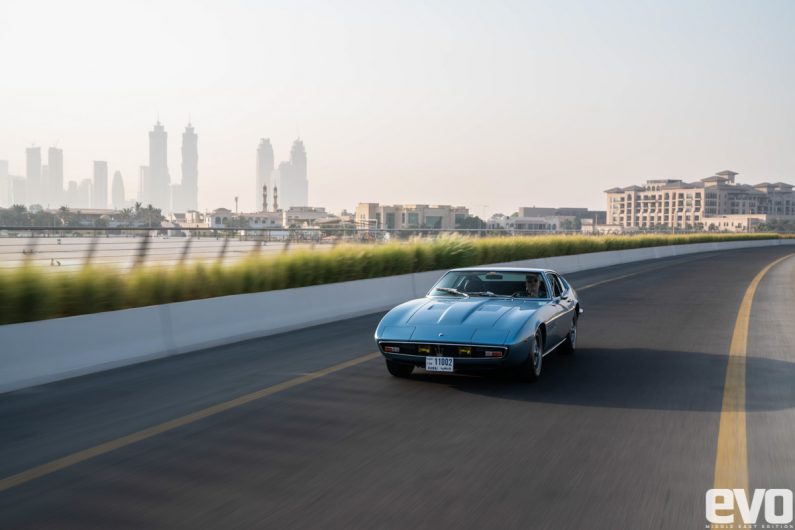
In the metal, the wide, muscular classic grabs attention and has huge presence, oozing sensuality at rest and taking possession of the road while on the move, scything through the air. It drips with delightful details, like those pop-up headlamps, the dainty chrome brightwork and badges, the twin fuel tank lids, the gaping bonnet vents and the quarter light windows that made it more palatable for occupants to have a smoke while driving. The alloy wheels must have looked futuristic at the time (Borrani wires were available as a no-cost option but few Ghiblis were so fitted) and the slender, elegant exhaust pipes finish things off with more than a hint of power and speed.
Inside it feels wide, with generous footwells and high window sills. Slung low, ensconced in its shapely leather seats, you’re faced with a large, beautiful wooden steering wheel and a dash that’s typical of Italian exotics of the time – lots of white-on-black dials and a bank of rocker switches for lights, wipers, town and country horns, twin fuel tanks, air conditioning and all the rest. Of course, none of them are labelled, so a new owner would need to spend some serious quality time getting used to what they all did through trial and error.
Starting it is almost ceremonious. Turn the key, listen to the various clicks, whirrs and hums as the fuel pump is primed, before eight cylinders erupt into a beautifully promising rumble. It’s not particularly refined but it does sound magnificent even at idle.
Get it onto the open road and it’s fast but not alarmingly so, delivering dollops of smooth, torque-rich thrust through beautifully spaced gearing in its ZF ’box. It feels utterly perfect and quite why anyone would opt for an auto when the stick shift is this sublime is beyond me. Using 6300rpm, 100kph is possible in second, a theoretical 270 flat out – numbers many run-of-the-mill cars are capable of now but, back in the day, this was seriously quick.
Its beautifully weighted power steering makes the hefty Ghibli a far more attractive daily proposition than almost any classic car I’ve yet experienced and, while the rear suspension is practically agricultural in its design, it never seems to get out of shape, just making for steady and rapid progress. It handles neatly and with balance on tight corners, and is supremely stable on fast sweepers. Other Italians of its era might be more electrifying as drivers’ cars but none offer such a perfect blend of performance and luxury. I could drive this thing until the wheels came off, it’s that satisfying, and the effect it has on other motorists is obvious: this is from an altogether more glamorous age of transportation and its beautiful, flawless form is highly appreciated.
And so to the present – I find the latest Ghibli visually appealing in the extreme. It just about manages to edge away from ordinariness with curves, creases and folds that harmoniously yet aggressively blend into a nicely resolved shape. The short rear overhang, the angry snout – if you want to stand out in the company car park, this one’s for you. And it’s a beautiful thing to sit inside, too. Perhaps not as aromatic as I expected, the leather bound interior is nevertheless a special environment, although I find the carbon fibre addenda of the GranSport a tad vulgar. The seats are armchair comfy, the feel of every surface smacks of quality and the ergonomics are vastly improved over Maseratis of old.
Close the frameless door and that impression of quality continues with a pleasing thunk. Press the start button and revel in the aural pleasures of a throbbing six-cylinder lump up front that brings a smile to your face. There’s no mistaking this for anything other than a sports car, albeit one with four doors and a decent boot.
At low speeds, it sounds like a Porsche flat-six and that’s no bad thing. But open it up and the exhaust note becomes a full-on roar (at least with Sport selected) that actively encourages you to drive it like you stole it. The suspension is stiff enough to give Merc drivers palpitations, but that’s the trade off, because this is no cosseting barge – it’s a focused driving machine tuned for plenty of thrills.
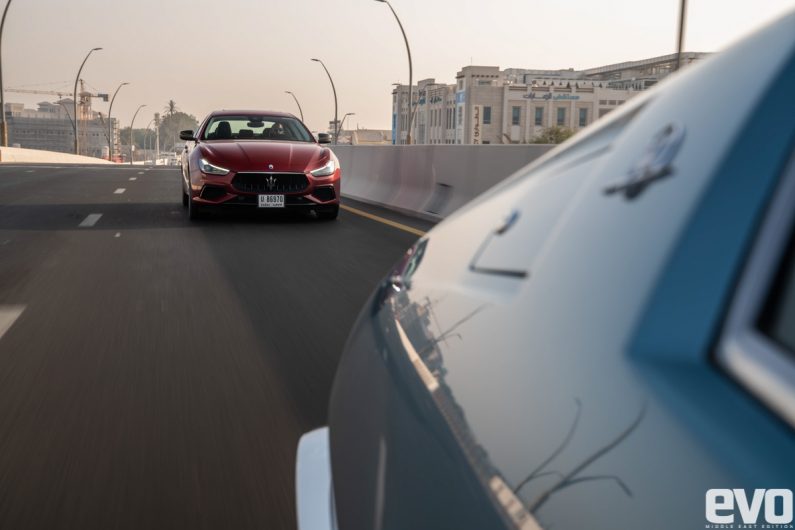
This current model is much improved over the last one I drove. Its steering is now a fully electric set-up instead of hydraulic, which makes for better fuel efficiency but doesn’t seem to adversely affect its precision or feel. There are additionally plenty of electronic safety systems that were absent at launch, like adaptive cruise control, lane keep assist, adaptive lighting and other worthy functions that have helped the Ghibli bag a five-star rating in the Euro NCAP tests.
This really is progress but there are still areas in which the Ghibli struggles to compete dynamically with the very best cars in this class. The biggest problem is power-to-weight. Its performance saloon rivals can kick its derriere and, as lovely as it is to look at and drive, perhaps it really does need a V8 range topper to become more relevant in the eyes and minds of potential buyers.
It’s a class act, no doubt about it, but the Ghibli – even in S GranSport form – still doesn’t offer the complete package like the original. But it does beg the question: is the classic GT car still relevant? The new one would be just as quick and comfortable on a long journey, not to mention safer and more frugal while the technology contained within would make even the most epic voyages perfectly enjoyable. Many cars nowadays have multiple personalities and can multi-task in ways that would have seemed impossible just a couple of decades ago.
Perhaps the original Ghibli really does represent the end of a golden era that has long since ceased to be, like the Grand Tour itself. However, like the activity that gave birth to this genre of motoring, the impact it has had on society cannot be underestimated. The Ghibli remains one of the true greats of all time and, for modern-day Maserati, it should serve as a potent reminder of the power that badge once wielded. It’s time to make Maserati great again..
| Maserati | Ghibli GrandSport S | Ghibli SS V8 |
|---|---|---|
| Engine: | Twin-turbo V6, 2979cc | V8, 4930cc |
| Power: | 424bhp @ 5750rpm | 335bhp @ 5500rpm |
| Torque: | 427lb ft @ 2250rpm | 341lb ft @ 4000rpm |
| Transmission: | 8-speed automatic, rear-wheel drive | 5-speed manual, rear-wheel drive |
| Suspension: | Double wishbone, independent (front), multi-link (rear) | Double wishbone, independent (front), leaf springs (rear) |
| Brakes: | Discs, 360mm (front) and 345mm (rear) | Discs, 294mm front and 272mm (rear) |
| Wheels: | 20-inch, alloy | 15-inch, alloy |
| Tyres: | 245/35YR20 (front), 285/30YR20 (rear) | 205/70VR15 (front and rear) |
| Weight: | 1810kg | 1300kg |
| 0-100kph: | 4.9secs | 6.5secs |
| Top speed: | 286kph | 280kph |
| Basic Price: | $105,000 | $350,000 |

